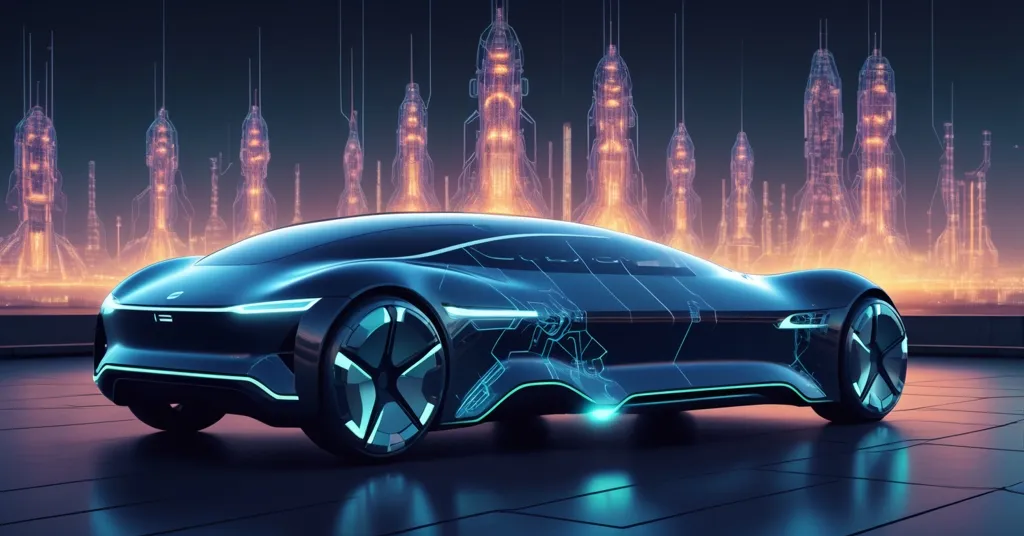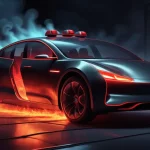Elon Musk Unveils Tesla AI5 Chip Partnership with Samsung and TSMC for Autonomous Tech Push

Elon Musk Drops Bombshell: Samsung and TSMC to Power Tesla’s AI5 Chip Amid Autonomous Tech Push
Elon Musk has once again grabbed headlines, announcing during Tesla’s third-quarter earnings call that Samsung Electronics and TSMC will jointly produce the AI5 chip, a pivotal piece of hardware driving Tesla’s self-driving software and Optimus humanoid robots. This strategic dual-production move, paired with Samsung’s massive $16.5 billion deal for AI chips, underscores Tesla’s hunger to scale autonomous tech while dodging supply chain pitfalls. But with Musk’s lofty promises of robotaxis by late 2023 and robots that could perform surgery, are we witnessing the dawn of a tech revolution—or just another chapter of overhyped dreams?
- Dual Production Powerhouse: Samsung and TSMC to split manufacturing of Tesla’s AI5 chip, with Samsung also on board for AI6.
- Historic Deal: Samsung secures a $16.5 billion contract, a major milestone for its foundry business.
- Big Vision, Big Risks: Musk touts robotaxi launches in 2023 and a poverty-free future with Optimus, but skepticism looms large.
AI5 Chip Production: A Strategic Play for Resilience
Tesla’s decision to tap both Samsung Electronics and TSMC for AI5 chip production isn’t just a manufacturing update—it’s a masterstroke of pragmatism in a volatile semiconductor landscape. The AI5 chip serves as the brain of Tesla’s self-driving system, processing mountains of data in real-time to make split-second decisions on the road. Think of it as a supercomputer on wheels, crunching numbers to navigate traffic or power the intricate movements of Optimus, Tesla’s humanoid robot. By splitting production between two industry giants, Tesla avoids the trap of a single point of failure, a concept we Bitcoin enthusiasts know well from the distributed resilience of decentralized networks.
Samsung’s role is particularly noteworthy. Already confirmed for the AI6 chip and having worked on the AI4, the South Korean titan has inked a $16.5 billion deal with Tesla—one of its largest external foundry orders ever. This isn’t just a cash grab; it’s a bold statement in the cutthroat foundry market where TSMC holds a dominant grip, producing roughly 90% of the world’s most advanced chips. Samsung’s aggressive push, bolstered by a new semiconductor hub near Tesla’s Austin, Texas base, offers logistical synergy—think shorter shipping times and tighter collaboration. TSMC, meanwhile, brings unmatched expertise and capacity, ensuring Tesla isn’t left high and dry if one supplier stumbles. Remember the global chip shortages of 2021? Tesla had to halt production lines due to part scarcity. Dual sourcing is like having two chefs at a feast—if one kitchen burns down, the other keeps the party alive. For more details on this partnership, check out the update on Tesla’s AI5 chip production with TSMC and Samsung.
But why does this matter beyond Tesla’s bottom line? For us in the crypto space, it’s a reminder of how critical infrastructure underpins innovation. Just as Bitcoin’s mining hardware evolved from CPUs to specialized ASICs to scale the network, Tesla’s reliance on cutting-edge AI chips—supplemented by Nvidia’s market-leading hardware—shows how specialized tech drives disruption. Could these chips one day power decentralized AI applications on blockchain platforms? While Tesla isn’t talking crypto yet, the principle of diversifying supply chains echoes the ethos of decentralization we champion. No central authority, no choke point—just raw, resilient progress.
Robotaxis: Autonomy Meets Disruption
Musk didn’t stop at chips during the earnings call. He doubled down on Tesla’s robotaxi ambitions, promising a launch in Austin by the end of 2023 with fully driverless vehicles, expanding to 8-10 cities by late 2025. Early iterations will include human drivers for safety, but the endgame is clear: a fleet of autonomous cars redefining transportation. Musk hyped the scale, claiming there are
“millions of cars out there that, with a software update, become full self-driving cars,”
while Tesla produces “a couple million a year.” He even described the rollout’s potential as something that will
“take off like a shock wave.”
Yet, the numbers tell a sobering story. Only 12% of Tesla owners currently pay for FSD Supervised, the partially automated driving system that still requires human oversight, despite heavy promotions like free trials. If adoption remains this sluggish, how will Musk convince the masses—or regulators—to embrace driverless cars en masse? Let’s not forget past promises: Musk predicted robotaxis by 2020 back in 2019, a deadline that came and went with little more than prototype demos. Regulatory hurdles add another layer of grit—several U.S. states outright ban unsupervised autonomous vehicles, and public trust in self-driving tech took a hit after high-profile accidents involving Tesla’s Autopilot.
For crypto enthusiasts, there’s a tantalizing “what if” here. Imagine a fleet of robotaxis powered by decentralized smart contracts on Ethereum or another blockchain, handling bookings and payments in Bitcoin or stablecoins without a middleman. Trustless ride-sharing, immutable accident logs, peer-to-peer fares—these aren’t sci-fi fantasies but plausible extensions of today’s tech. Startups have already toyed with blockchain for mobility solutions; Tesla could be the giant to make it mainstream. Musk flirted with crypto before, briefly accepting BTC for Tesla purchases in 2021. Could autonomous vehicles revive that spark? It’s a long shot for now, but the seeds of a decentralized transport economy are worth pondering.
Optimus and Musk’s Utopian Vision
Then there’s Optimus, Tesla’s humanoid robot, which Musk pitched as nothing short of world-altering. He claimed,
“Optimus will be an incredible surgeon,”
envisioning a machine so precise it could rival human doctors. A new version, Optimus V3, is slated for a demo in Q1 2026, and Musk tied it to a sweeping vision of societal transformation, saying,
“You can actually create a world where there is no poverty, where everyone has access to the finest medical care.”
It’s an audacious dream, painting Optimus as potentially “the biggest product of all time.”
Let’s pump the brakes. While AI and robotics are advancing, the idea of a robot surgeon—or one eradicating poverty—is light-years from reality. Current humanoid robots struggle with basic tasks like walking without tripping, let alone wielding a scalpel. Musk’s timeline feels more aspirational than a New Year’s resolution, and the ethical quagmire of job displacement looms large. Could robots replace workers on a massive scale, creating more inequality before solving it? Compare that to blockchain’s immediate empowerment—Bitcoin gives individuals financial sovereignty today, not in some distant utopia.
Still, the disruptive spirit resonates. If Optimus ever matures, could it run on decentralized networks for transparency or data security? Might it accept crypto for services in a future gig economy? These are speculative leaps, but they align with our push for effective accelerationism—tech that challenges the status quo, much like Bitcoin did to traditional finance. Musk’s vision, however wild, keeps the conversation moving forward.
Critical Lens: Hype vs. Reality
Now, let’s play devil’s advocate with a sledgehammer. Musk’s earnings call felt like a sci-fi TED Talk, sidestepping gritty realities for shiny promises. No word on EV demand, nothing about Cybertruck delays, zero on looming tariffs or the expired federal tax credits, and not a peep of Q4 guidance. Instead, it was all robotaxis and robots, perhaps a slick distraction from cracks in Tesla’s core business. With Musk’s controversial $1 trillion pay package still sparking debate, is this visionary rhetoric just a way to keep investors starry-eyed?
His track record doesn’t inspire blind faith. Full Self-Driving has been “next year” for nearly a decade, with missed deadlines piling up like unpaid parking tickets. Robotaxis by 2020? Nope. Widespread FSD by 2022? Still waiting. Add to that the measly 12% adoption of FSD Supervised, and you’ve got a recipe for skepticism thicker than concrete. Then there’s Optimus—most people wouldn’t trust a robot to cut their steak, let alone their skull. Regulatory and public pushback on autonomous tech could turn Musk’s “shock wave” into a ripple, and a robot-driven utopia sounds like a distraction from today’s very real economic divides.
On the flip side, let’s not dismiss the man outright. Musk swings for the fences, and even if he strikes out half the time, the hits—think SpaceX or Tesla’s early EV dominance—change the game. His dual-production strategy with Samsung and TSMC is a grounded move, showing a knack for logistics amid chaos. For us in the crypto world, that resilience mirrors Bitcoin’s survival through bans, hacks, and FUD. Could Tesla’s AI push, if it delivers even half of what’s promised, intersect with decentralized systems in ways we can’t yet predict? It’s not impossible, but execution is everything. Hype is cheap—results are the real currency.
Key Takeaways and Questions for Crypto and Tech Enthusiasts
- How does Tesla’s AI5 chip production strategy reflect decentralization principles?
By partnering with Samsung and TSMC, Tesla avoids reliance on a single supplier, echoing Bitcoin’s distributed design where no central failure can halt progress. - Could robotaxis integrate with blockchain or crypto payments in the future?
Absolutely—autonomous vehicles might leverage blockchain for secure data or accept Bitcoin for fares, paving the way for a trustless transport economy, even if Tesla hasn’t signaled this yet. - What risks does Musk’s hype pose compared to overblown crypto projects?
Similar to scam ICOs or absurd altcoin promises, Musk’s ambitious claims risk disillusionment if delivery lags, reminding us to approach tech and crypto with a critical eye. - How does Tesla’s AI push compare to blockchain’s disruptive potential?
Tesla’s AI targets long-term shifts in transport and labor, while blockchain disrupts finance now; Musk’s goals are speculative, but crypto’s impact is already tangible. - Should crypto enthusiasts care about Tesla’s autonomous tech developments?
Yes—AI and autonomy could eventually mesh with decentralized systems for payments or data security, bridging physical innovation with our digital financial revolution.
Lessons for Decentralized Tech
Stepping back, Tesla’s latest moves—from AI5 chip production to robotaxi dreams—aren’t just a tech story. They embody the relentless drive for innovation we celebrate in Bitcoin and blockchain. Splitting production between Samsung and TSMC mirrors the robustness of decentralized networks, ensuring no single snag derails the mission. Musk’s broader vision, while often unmoored from timelines, carries the same disruptive DNA as crypto’s challenge to centralized finance. Yet, we can’t ignore the potholes: regulatory battles, public skepticism, and Musk’s history of delayed promises could stall this juggernaut.
For us Bitcoin maximalists and crypto advocates, the real intrigue lies in the uncharted intersections. Could a robotaxi accept BTC for a ride? Might Optimus one day operate on a blockchain for transparent task logging? Musk hasn’t whispered a word about such ideas, but the potential simmers. Tesla’s gamble is a high-stakes bet, much like Bitcoin’s early days when few believed in its staying power. Will it reshape the world, or buckle under its own ambition? The answer could ripple through decentralized tech in ways we’re only beginning to imagine. For now, we watch, root for disruption, and demand the proof—not just the pitch.



